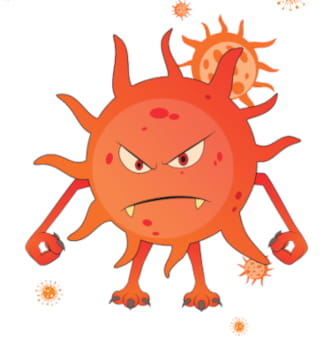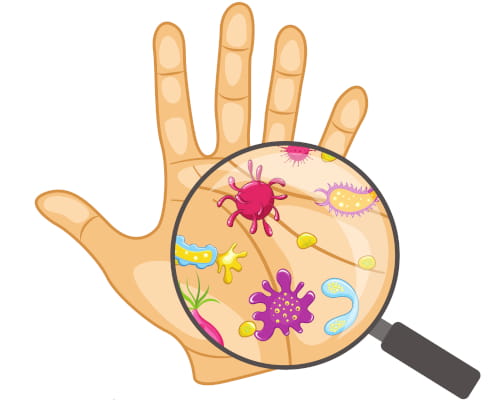As students return to classrooms after winter break – bringing their germs with them – it's a good time to refresh our hand hygiene technique. But, after living through a pandemic for three years, many kids may be tired of hearing about it and really sick of DOING it! In fact, a recent study by the Global Hygiene Council showed that globally, almost half of 5-10-year-olds (42%) are not always washing their hands with soap at school.1 This is a serious issue since handwashing with soap and water is one of the best ways to reduce germs that may cause illness.
We all know that K-12 schools are especially germy settings, and parents and teachers everywhere have daily battles with kids to not only wash their hands correctly – but even to do it AT ALL – especially when it matters most, like after using the restroom, before eating, and after coughing or sneezing. The first part (teaching how to wash correctly) is actually the EASY part. Tricks like putting up signs as reminders, modeling how to do it properly, and coaching students to sing the "Happy Birthday Song" or "ABCs" as they wash, are tried-and-true approaches.
The second part is trickier – what should you do if students CAN wash their hands but WON'T? In addition to teaching children how to wash their hands correctly, it's important to explain the "why." For example, it's easy to say, "Washing your hands will help stop germs from making you sick." But, to really get a child to engage – like with anything else – you must make it interesting AND fun AND give them a good reason to do it. I hope this blog will help bring back a bit of fun into the handwashing conversation with five weird but true facts about soap and a few tips to encourage kids to use it.
Did you know?
- Soap has been around for at least 4,800 years – as long as the oldest living tree on the planet!2,3 In fact, ancient Egyptians used a material similar to our modern-day soap.
- According to Roman legend, soap was named for the mythical Mount Sapo.4 Legend has it that clothes washed in a nearby river would get cleaner, faster. Although Mount Sapo may be fictional, the word "sapo" in Latin does translate to "soap."
- In the late 1800s, a gangster called "Soapy" Smith5 operated a scam where he sold bars of soap with prize money hidden in some of them, but most, if not all, bars did not contain any dollar bills!
- Blowing air through a straw into your drink to make bubbles is the same process that foam soaps are made by! Foaming soap starts as a watery liquid. When the soap container is pumped by hand or dispensed from an automatic dispenser, air is injected into the liquid, creating the foam that emerges.
- An automatic soap dispenser uses infrared sensors – the same technology in night vision goggles! Infrared sensors in the soap dispenser detect infrared energy that is emitted by body heat. When hands are placed near the sensor, the infrared energy quickly fluctuates and triggers the pump to activate and dispense the designated amount of soap.
Here are a few additional tricks to use in classrooms to reinforce the importance of handwashing in a fun and memorable way:
- Bring in the "gross factor" (in an age-appropriate way). For example, have children guess how many germs one germ can multiply into in a single day. (Answer: more than 8 million germs!) Or that germs can spray up to 6 feet when you flush the toilet.6
- Explore different soap formats. Some soaps are more fun to use, such as foaming soaps or bars that have interesting shapes.
- Do an experiment. Instead of just modeling how to wash, use one of the below experiments developed by GOJO scientists to teach and reinforce the importance of handwashing:
Experiment for K-2nd grade: The Importance of Handwashing. Kids love finger painting, and while it's a great exercise in creativity, you can use it to illustrate how germs can stay on hands, even after washing with soap and water.
- Start by putting a small amount of washable finger paint in each student's hand and have them rub their hands together until they're completely covered in paint.
- Then, divide the students into 2 groups and have each student wash their hands – with a blindfold on. Group 1 should wash per the CDC guidelines, and Group 2 should wash normally.
- Pat each student's hands dry with a paper towel and press them against a white sheet of paper. Any paint transferred to the paper – or left on the student's hands – represents germs left behind after washing.
- Compare Groups 1 and 2 to see which handwashing method works best.
Experiment for 3rd-6th grade: Understanding Germ Transfer. Showing students how easily germs can move from hands to common objects – and back – is a great way to illustrate how washing your hands can help prevent the spread of germs. Seeing how quickly germs can spread around the classroom helps reinforce good hand hygiene and can encourage students to pay more attention to when and how well they're washing and sanitizing their hands.
- Apply a nickel-sized amount of Glo Germ gel to each student's hands and have them rub the gel ONLY into the palms of their hands.
- Before the gel dries completely, have students touch what they believe to be the 5 most-touched objects in the classroom.
- Turn off the lights and make the room as dark as possible. Then turn on a black light and walk around the room, showing how many times various items are touched.
- Discuss how germs can be transmitted to and from surfaces throughout the day and how hand hygiene can help break this cycle.
Experiment for 7th-12th grade: The Effectiveness of Hand Hygiene Techniques. Older students can still benefit from learning the advantages of good hand hygiene too. Break out those microscopes and have students swab the same area before and after washing their hands and compare the number of germs from each swab. It's a great way to demonstrate the importance of hand hygiene and learn what common germs on hands look like in real life! The full experiment outline is available on the PURELL® Brand K-12 Well-Being Center.
These experiments provide a hands-on and fun way to reinforce good handwashing technique and help students understand how quickly hands can transmit germs so that students can focus on washing and sanitizing their hands more frequently, with good form.
Get the accompanying worksheets for these experiments and other hand hygiene tips and resources for teachers and K-12 school staff by visiting the PURELL® Brand K-12 Well-Being Center. Do the experiment and share your story on TikTok – don’t forget to tag @PURELL!